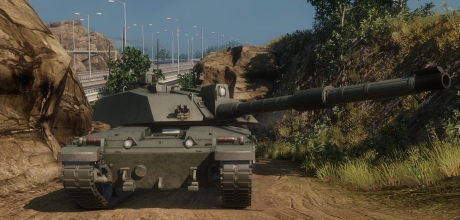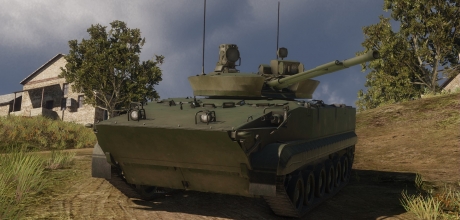
The M48 and M60 series of tanks has a long service history both in the military of the United States of America and in other countries of the world. These tanks were at first equipped with 90mm and later 105mm rifled guns, but there’s one exception to that rule: the M60A2, which is commonly known under its nickname “Starship.” The M60A2 is, much like Sheridan, equipped with a 152mm gun-launcher that can fire guided missiles. But how did such a device find its way onto the Patton chassis?

To answer that question, we must travel back to 1958 when a guided missile was recommended by tank development experts from the ARCOVE group as the armament of future American MBTs. This report launched a development process that eventually resulted in the 152mm XM81 gun-launcher, capable of firing Shillelagh missiles. There were several advantages to this system over the standard 105mm gun – at least on paper:
- The gun-launcher was considerably smaller
- It weighed half as much as the M68 rifled cannon
- The large caliber allowed for more powerful HEAT and HE rounds with bigger warheads
- Shillelagh missile launching capability
- Combustible casings were cheaper to manufacture than classic shells
Additionally, the gun-launcher’s properties allowed its installation not only on Medium Tanks, but also Light Tanks (specifically the Sheridan). Several destructive rounds were developed for it including the XM409 HEAT round (capable of penetrating 178mm of armor at 60 degrees) and a White Phosphorus round called XM410. Then there was the Shillelagh missile of course, fully capable of penetrating any contemporary Main Battle Tank, but ineffective at ranges below 1000 meters, a fact that would become important later on.
All this impressed the American military and preparations were made to install this powerful new weapon on the M60 chassis. A full-scale mockup (demonstrating the possibility of XM81 installation) was built in 1961 using the M60A1 turret with the gun-launcher installed along with a new mantlet, sights and the Shillelagh missile guiding system. At this stage of development, the M60A1 was, however, still referred to as M60E1 and therefore this new variant was referred to as M60E2 (with the M60E3 designation planned for the finalized variant). The idea was that this solution (using the standard turret with different mantlet, optics and missile guiding system) would allow for very fast conversion of existing M60E1 (future M60A1) tanks.
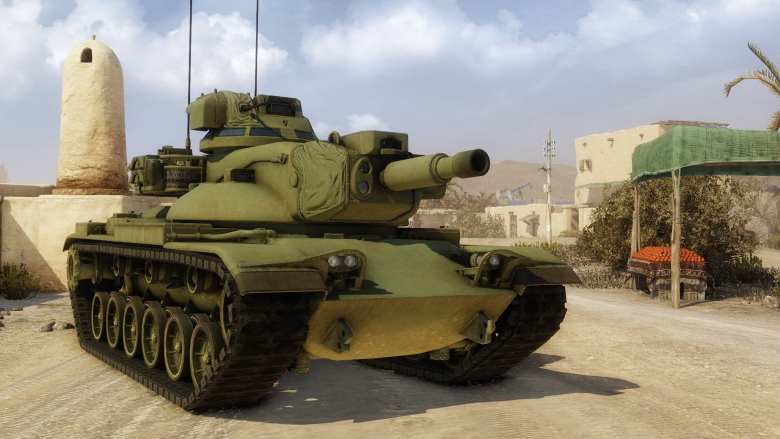
At the same time, however, a new solution appeared – a new turret that was intended for another paper project for future American tank, the MBT (MR) program. The MR stood for Medium Range – in this case, however, the word “range” referred to time instead of distance – specifically to the fact that the vehicle was to be ready for production within 5 years.
The turret was very compact – and a reduced frontal silhouette provides a massive advantage in tank combat. Its development was based on the idea of using an automatically loaded remote-controlled gun installed in the turret while having the crew below the turret in an armored capsule. The list of advantages was considerable: its small size allowed for very low weight and exceptionally good frontal turret protection. On the other hand, the crew could see out rather poorly – only the vehicle commander had 360 degrees view, the gunner and the loader could only see their respective sides of the turret.
In the end, four different concepts were considered by the Department of the Army in January 1964:
- Type A based on the compact turret described above with a remote-controlled 20mm cannon against helicopters
- Type B based on the compact turret described above with a remote-controlled 20mm cannon against helicopters
- Type C with a new conventional turret comparable in shape to the Sheridan Light Tank, also with a 20mm cannon
- Type D with modified M60E1 turret (shorter, adapted for the installation of XM81)
Type C was discarded quite early on and after some deliberations, Type B was selected as the winner with Type A and D being left in reserve. For the duration of the tests, all four concepts were referred to as “XM66”, but in February 1965, the Type B variant received a more specific designation: M60A1E1. The M60A1E1 was to be armed with the XM162 gun-launcher. The jump from XM81 to XM162 was a rather curious one – there were numerous variants of the XM81, designated by E numbers as usual. The latest was to be the XM81E13. For reasons unknown, but speculated to be superstition since 13 is considered an unlucky number by some, the XM81E13 designation was changed to XM162.

The first two M60A1E1 prototypes were delivered in November 1965 and February 1966 and were trialed for several months with the third prototype joining them in August. These trials didn’t exactly go well for the vehicle, just like with the Sheridan, the guns misfired, the gun blasted into the turret and the ammunition detonated prematurely. All these issues were connected to the combustible shell case and would only be fixed (but not before at least one fatal accident, related to Sheridan development). Needless to say, these issues led to development delays and did not exactly inspire crew confidence. Further modifications were made to the vehicle based on the trials and this improved version (referred to as M60A1E2) was approved for production and later on received its official designation: 152mm Gun Full Tracked Combat Tank M60A2.
The M60A2 consisted of the new M60A1E2 turret mated with the classic M60A1 hull. The M60A1 hull was all-steel with the following thicknesses:
- Upper frontal hull plate: 109mm (angled at 65 degrees)
- Lower frontal hull plate: 143-85mm (angled at 55 degrees)
- Side hull armor: 74-36mm
- Rear hull armor: 41-30mm (the grill was 25mm thick)
- Hull bottom: 19-13mm
- Hull top: 36mm
The all-steel turret was, on the other hand, better frontally protected than the one of the M60A1:
- Gun mantlet: 292mm
- Turret front: equal to 292mm
- Turret sides: 121mm
- Turret rear: 64mm
- Turret top: 32mm
As you can see, the frontal protection increased practically two-fold. The vehicle was powered by the same engine as the M60A1 – the AVDS-1790-2A diesel, producing some 650hp. The combat weight of the vehicle was, however, in the end higher – compared to the M60A1, it increased from 47.63 to 51.89 tons. The maximum sustained speed, however, remained the same (48 km/h, 30 mph).
Then of course there was the gun: the 152mm Gun-Launcher received its finalized production designation M162. The gun was stabilized, and could elevate to +20 degrees and depress to -10 degrees. Compared to the prototype version, the vehicle eventually received new types of ammunition – XM617 canister round and the devastating XM625 “Beehive” round, capable of literally shredding an entire squad of troops at close distances with 9900 steel flechettes contained in each shot. The vehicle carried 33 standard rounds and 13 Shillelagh missiles.
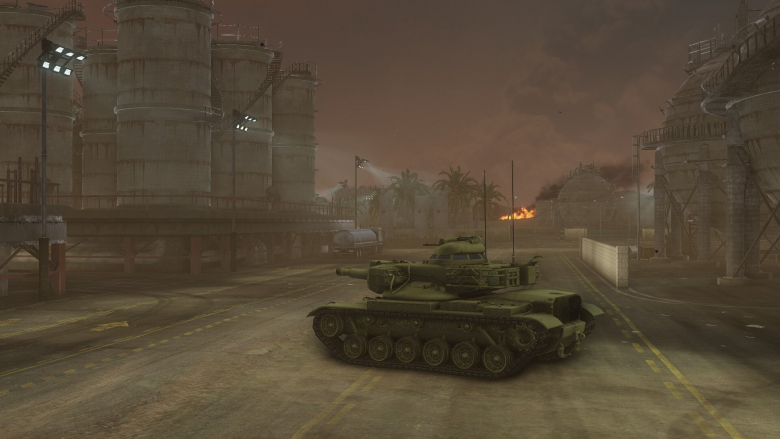
The M60A2 was built by Chrysler and entered production in 1973, but it didn’t last long. The production was ended as early as in 1975 after mere 2 years with 540 tanks built (army records, however, indicate only 526 built). This fact alone speaks volumes about the number of issues that came with this vehicle.
First, there was the limited night fighting capability. The short range of available night vision devices meant that the firing range was limited at night to mere 600 meters, making missiles unusable. The range could be extended to 1000 meters by using the installed xenon searchlight, but turning on the searchlight on the battlefield lit the tank up like a Christmas tree and was generally considered asking to be fired upon. Needless to say, it wasn’t popular with the crews either and the missiles were STILL unusable even when they did so.
Then there was the inability to mount a standard (coincidence) range-finder on the narrow turret, which negatively affected firing accuracy. In effect, what the army received was a tank that could not effectively kill other tanks at night and was plagued by gun and electronics issues. The vehicle was generally quite complex, unreliable, maintenance-heavy and disliked by its crews.
But what really doomed the M60A2 was the development of anti-HEAT measures such as ERA, spaced armor kits and, of course, composite armor. Faced with these developments, the U.S. Army saw no choice but to return to kinetic penetrators and the M60A2 was retired in 1981, only half a decade after its introduction. It was never exported, but a number of these vehicles made it to Europe after 1974 and stayed there until being replaced by more conventional tanks. Most of the retired M60A2s were converted back to standard M60 configurations (M60A3) or converted to engineering vehicles.
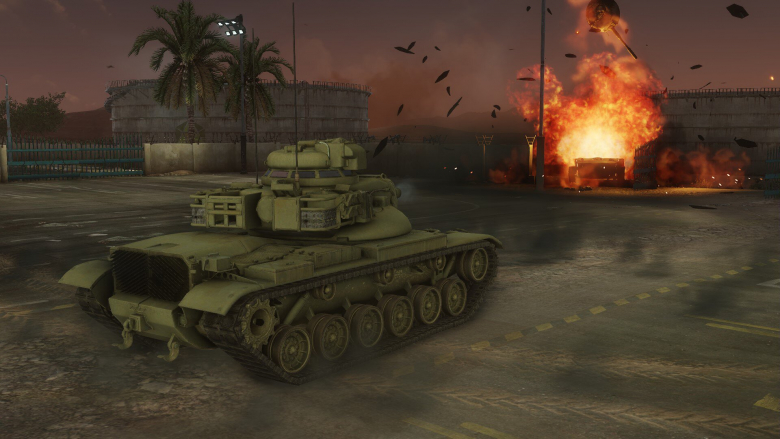
Regarding the nickname “Starship”: R.P.Hunnicutt, whose work is generally considered to be the bible of U.S. tank literature, mentions it as a nickname the crews gave their tanks because either it was too complex to operate, or because the interior reminded them of the popular TV show “Star Trek”. Newer research (N.Moran), however, indicates that the name might have emerged only after the tank left service. This is generally not unheard of. Several “popular” vehicle nicknames emerged this way, usually thanks to plastic kit producing companies and internet communities. At this moment, the true origin of the nickname remains unclear.
In Armored Warfare
Un Update 0.19, the previously Tier 4 M60A2 will be a Tier 5 choice, available from Tier 4 M60A1 Patton, one of the newly introduced vehicles. A classic Patton hull combined with a powerful 152mm gun that is capable of firing guided missiles will make for an interesting high-alpha gameplay. The reason for this shift from Tier 4 to Tier 5 consists of two parts:
- The rebalanced vehicle is too powerful for Tier 4 (taking the new Balance 2.0 mechanics as well as its properties into account)
- M60A2 on the same tier as M60A3 is historically more accurate, representing two different approaches - what should have been the replacement for M60A1 (M60A2) and what actually became the replacement (M60A3)
For more details about vehicles switching Tiers, please visit our Compensations and Progression Balance 2.0 articles.
We’ll see you on the battlefield!




